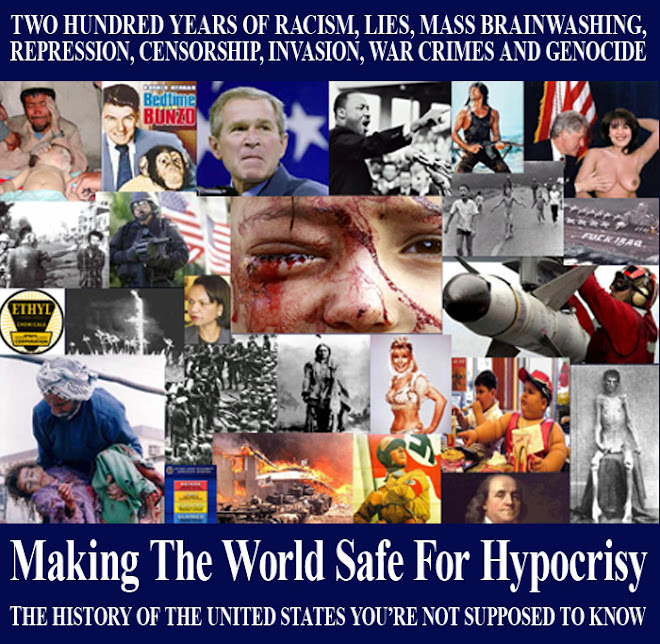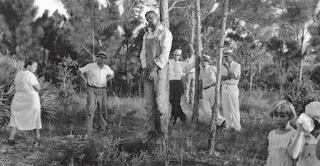1880s-1998: UNITED STATES. The United States Census Bureau estimates that 4,742 lynchings took place in the U.S. between 1882 and 1968. Between 1882 and 1930, some 2,828 people were lynched in the South; 585 in the West; and 260 in the Midwest. Most of the victims of lynching were black males although some black females and some Chinese, Italians and Jews fell victim to American lynch mobs. Prior to the mass outbreak of lynching in the 1880s, Americans had lynched at least 163 Mexicans, including women, in California in the period 1848-1860. The Mexicans, whose state had been stolen from them by the U.S. in 1846, were competing with American gold miners and so were duly murdered.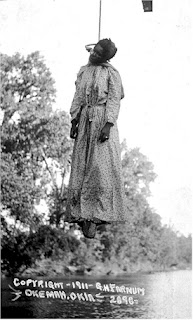 Lynching often included torture and mutilation. Victims were flogged, had ears, fingers and other body parts cut off. Females were raped. Many victims were burned alive. Victims were sometimes castrated. Body parts such as teeth, fingers, clothes and sexual organs were sold as souvenirs. The February 2, 1893 edition of The New York Times described the lynching of Henry Smith in Paris, Texas. Smith was placed on a ten foot scaffold and tortured for almost an hour with red-hot irons. He was then burned alive.
Lynching often included torture and mutilation. Victims were flogged, had ears, fingers and other body parts cut off. Females were raped. Many victims were burned alive. Victims were sometimes castrated. Body parts such as teeth, fingers, clothes and sexual organs were sold as souvenirs. The February 2, 1893 edition of The New York Times described the lynching of Henry Smith in Paris, Texas. Smith was placed on a ten foot scaffold and tortured for almost an hour with red-hot irons. He was then burned alive.
Ministers of the Christian religion and business leaders participated and, often a holiday atmosphere prevailed. Railroads sometimes ran special excursion trains to allow spectators to watch lynchings. Crowds as large as 15,000 attended lynchings, sometimes buying tickets for the privilege.
 Photographic postcards of lynchings were common and the U.S. Post Office gladly carried them as mail until 1908. The last officially recorded lynching in the U.S. took place in 1968 but many consider the 1998 murder of James Byrd in Texas, by three whites who hauled him behind a pick-up truck with a chain, to be a lynching.
Photographic postcards of lynchings were common and the U.S. Post Office gladly carried them as mail until 1908. The last officially recorded lynching in the U.S. took place in 1968 but many consider the 1998 murder of James Byrd in Texas, by three whites who hauled him behind a pick-up truck with a chain, to be a lynching.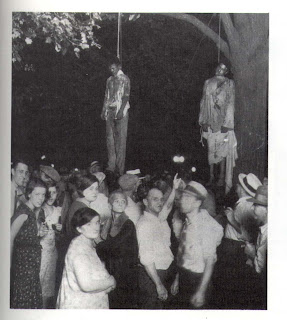 Americans used lynching and other terror tactics to intimidate blacks and other oppressed groups into political, social and economic submission. Very few of the victims were accused of crimes such as murder or rape as is often thought. Most victims were accused only of such things as being boastful, insulting a white person, questioning the amount offered for goods or seeking employment beyond their allotted station. The torturers and murderers who carried out lynchings were almost never charged in spite of the fact that many lynchings were conducted in front of thousands of witnesses and that a huge amount of photographic evidence existed, much of it sent as postcards through the U.S. Mail.
Americans used lynching and other terror tactics to intimidate blacks and other oppressed groups into political, social and economic submission. Very few of the victims were accused of crimes such as murder or rape as is often thought. Most victims were accused only of such things as being boastful, insulting a white person, questioning the amount offered for goods or seeking employment beyond their allotted station. The torturers and murderers who carried out lynchings were almost never charged in spite of the fact that many lynchings were conducted in front of thousands of witnesses and that a huge amount of photographic evidence existed, much of it sent as postcards through the U.S. Mail.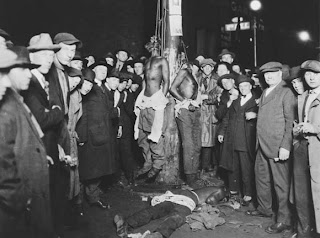 Some two hundred anti-lynching laws were presented to the U.S. House of Representatives over the years. Three bills managed to pass the House. All three were defeated in the United States Senate. In 2005, the Senate passed a resolution apologizing for its de facto sanctioning of lynching for over a century. In the year 2005, fifteen fine, upstanding American Senators refused to endorse the apology bill. Makes a fella real proud, don't it?
Some two hundred anti-lynching laws were presented to the U.S. House of Representatives over the years. Three bills managed to pass the House. All three were defeated in the United States Senate. In 2005, the Senate passed a resolution apologizing for its de facto sanctioning of lynching for over a century. In the year 2005, fifteen fine, upstanding American Senators refused to endorse the apology bill. Makes a fella real proud, don't it?
1885: GUATEMALA. The U.S. gunboat Wachusett invades Guatemalan waters to “protect U.S. interests”.
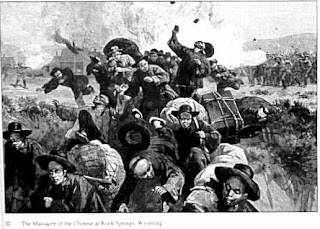 1885: UNITED STATES. Miners in the Harrimans' Union Pacific coal mine in Rock Spring, Wyoming have been struggling for years to unionize in order to secure a living wage and safer working conditions. The Harrimans have resisted at every turn and, seeing their Chinese co-workers as scapegoats, white miners go on a rampage and attack the Chinese. They murder at least twenty eight people and injure more than a dozen. More than fifty homes belonging to Chinese families are burned to the ground.
1885: UNITED STATES. Miners in the Harrimans' Union Pacific coal mine in Rock Spring, Wyoming have been struggling for years to unionize in order to secure a living wage and safer working conditions. The Harrimans have resisted at every turn and, seeing their Chinese co-workers as scapegoats, white miners go on a rampage and attack the Chinese. They murder at least twenty eight people and injure more than a dozen. More than fifty homes belonging to Chinese families are burned to the ground.
Inevitably, the "suspects" in the riots are quickly released and none is ever charged with a crime. On their release, the murderers are met by a crowd of hundreds and given an ovation for their fine work. Sure do make you proud, don't it?
1885: UNITED STATES. Sleeping Chinese hop pickers are massacred in the Squak Valley in Washington. Three are shot to death and three wounded.
1885: UNITED STATES. A racist mob burns a large part of Seattle’s Chinatown.
1885: UNITED STATES. A racist mob of three hundred, led by Tacoma, Washington mayor Jacob Weisbach and backed by the Tacoma police department, forces three hundred Chinese into boxcars and expels them from the city.
1885: COLOMBIA. U.S. troops invade Colon and Panama City in the Colombian province of Panama.
1886-ongoing: UNITED STATES. A Supreme Court decision in the tax case of Santa Clara County versus the Southern Pacific Railroad is often cited as leading to the legal status of "person" and consequent free speech and other rights for corporations, thereby guaranteeing protections under the First and Fourteenth Amendments of the U.S. Constitution to the abstract creations of corporate lawyers. In reality, the decision did no such thing. Chief Justice Morrison Waite wrote, "We avoided meeting the Constitutional question in the decision."
Yet, when preparing the case summary, the court reporter, former railroad president J.C. Bancroft Davis, wrote: "The defendant Corporations are persons within the intent of the clause in Section 1 of the Fourteenth Amendment to the Constitution of the United States, which forbids a state to deny any person within its jurisdiction the equal protection of the laws." The 14th Amendment had supposedly been written to protect recently-freed blacks from persecution and oppression, not to increase the power and wealth of railroads and other corporations.
Even though the court had not made the legal determination claimed in the headnote, the clerk's misrepresentation of the case lead to successful claims to the status of “person” for the legal abstraction of a corporation.
The back door granting of personhood paved the way to greater profits and almost unlimited political and economic power for corporations in the United States. Using the definition of corporations as "persons", the Supreme Court struck down a whole range of state regulations attempting to control the more rapacious activities of corporations. In 1938, Justice Hugo Black noted that, in the fifty years since Santa Clara, "less than one-half of one percent (of Supreme Court rulings which invoked the 14th Amendment) invoked it in protection of the Negro race, and more than fifty percent asked that its benefits be extended to corporations."
1886: UNITED STATES. State militia fire point blank into a crowd of striking steelworkers in Milwaukee calling for an eight hour work day. Seven people including a child are killed on the spot. The Milwaukee Journal reports that eight more victims will die within twenty four hours. The paper commends Wisconsin Governor Jeremiah Rusk, who had set the militia on the strikers, for his valiant efforts.1886-93: UNITED STATES. American and Canadian labor unions organize a general strike in support of an eight hour work day. Rallies are held throughout the U.S. and Canada with tens of thousands of workers turning out. A rally of 80,000 people marches in Chicago in support of the strike. Strikers at the factory of Mexican slave owners, the McCormick Harvesting Machine Company (International Harvester), are shot at by Chicago city police. Four strikers are killed and others wounded.
Organizers call for a protest rally at Haymarket Square in Chicago the following day. A bomb is thrown at a line of police advancing on the crowd, killing one policeman. Police then open fire on the crowd. At least four civilians are killed and as many as fifty wounded. Seven policemen are also killed and a large number wounded, almost certainly all by fellow policemen. Eight people are arrested and charged with the murder of the policeman killed by the bomb even though the prosecution concedes that none of the defendants was responsible for throwing the bomb. No police are charged with any crimes.
The U.S. mass media does its usual fine job of deceiving the population and inflaming public opinion by spreading fear of the "ism" du jour. In a hysteria piece called "Anarchy’s Red Hand", the New York Times calls the Haymarket massacre the "bloody fruit" of "the villainous teachings of the Anarchists" happily ignoring the fact that all but one of the victims were slaughtered by the forces of law and order. The Chicago Times describes the defendants as "arch counselors of riot, pillage, incendiarism and murder". The Atlantic Monthly states that workers have only themselves to blame for their lot in life. Seven of the defendants are condemned to death and one to fifteen years in prison. The verdicts inspire protests around the world.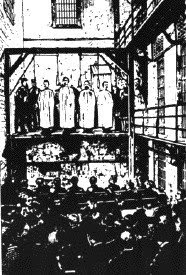 The case is appealed unsuccessfully all the way to that gleaming bastion of justice, the U.S. Supreme Court. Illinois Governor Richard James Oglesby then commutes the death sentences of two defendants to life in prison. One defendant commits suicide. Four are hung by the neck until they are dead.
The case is appealed unsuccessfully all the way to that gleaming bastion of justice, the U.S. Supreme Court. Illinois Governor Richard James Oglesby then commutes the death sentences of two defendants to life in prison. One defendant commits suicide. Four are hung by the neck until they are dead.
Workers believed that the bomb had, in fact, been thrown by an agent provocateur, probably working for Pinkertons, who were widely employed at the time by the owners of numerous corporations as goon squads. The bomb thrower was never identified. The commander who ordered the police to advance on the workers in Haymarket Square was later convicted of corruption. In 1893, Illinois Governor John Peter Altgeld showed remarkable integrity for a politician when he signed pardons for three of the executed defendants after he concluded that all eight defendants had been innocent. Altgeld said the real reason for the bombing was the city of Chicago's failure to hold Pinkerton guards responsible for shooting workers. The pardons duly end Altgeld's political career. Can't be havin' no integrity in politics.
 1886: UNITED STATES. A racist mob in Seattle, Washington rounds up the city's Chinese population and attempts to drive them onto waiting ships in order to expel them from the city. By March, virtually all people of Chinese descent have been driven from the fair city of Seattle.
1886: UNITED STATES. A racist mob in Seattle, Washington rounds up the city's Chinese population and attempts to drive them onto waiting ships in order to expel them from the city. By March, virtually all people of Chinese descent have been driven from the fair city of Seattle.
1886: UNITED STATES. Twenty black Americans are massacred at Carrollton, Mississippi.
1886: UNITED STATES. Robber baron Jay Gould who bragged that "I can hire half the working class to kill the other half," makes his point when he hires gunmen to murder workers striking against his railroad.1887: UNITED STATES. Ten thousand workers at sugar plantations in Louisiana are organized by a secret labor union, the Knights of Labor. The workers, about ninety percent black and ten percent white, earn about $13 a month. Thanks to the "company store" system, most become perpetually indebted to the sugar companies and, under Louisiana law, become vitual serfs of the companies. They go on strike for an increase in their pay to $1.25 a day. Louisiana Governor Samuel Douglas McEnery is outraged by the thought of blacks and whites working together to oppose oppression by the ruling class and declares that, "God Almighty has himself drawn the color line." The state militia is withdrawn, permitting lynch mobs to murder between twenty and thirty of the striking workers.
1887: UNITED STATES. Thirty four Chinese miners are slaughtered at Deep Creek, Oregon. The murderers then steal between $4-5000 in gold belonging to the victims.
 1887: HAWAII. A conspiracy of wealthy white Americans, consisting primarily of sugar producers and large landowners, forces the democratically-elected monarch of Hawaii, David Kalakaua, to sign a new Constitution under threat of violence by an armed militia called the Honolulu Rifles. The Honolulu Rifles are controlled by a secret society called the Hawaiian League, which wants Hawaii annexed by the U.S. in order to increase the profits on sugar by eliminating the tariff on Hawaiian sugar exported to the U.S. Because the Constitution was imposed under threat of violence, it is known as the Bayonet Constitution.
1887: HAWAII. A conspiracy of wealthy white Americans, consisting primarily of sugar producers and large landowners, forces the democratically-elected monarch of Hawaii, David Kalakaua, to sign a new Constitution under threat of violence by an armed militia called the Honolulu Rifles. The Honolulu Rifles are controlled by a secret society called the Hawaiian League, which wants Hawaii annexed by the U.S. in order to increase the profits on sugar by eliminating the tariff on Hawaiian sugar exported to the U.S. Because the Constitution was imposed under threat of violence, it is known as the Bayonet Constitution.
The new Constitution does a fine job of destroying Hawaiian democracy and, aside from being anti-democratic, has that classic all-American blend of racism and religious bullshit. Under the new Constitution, people of Asian descent, who formerly could participate in the Hawaiian democracy, are barred from voting solely on the basis of their race. Under the Bayonet Constitution, only wealthy male property owners are allowed to vote, effectively disenfranchising the majority of Hawaiians in their own country. Voting in the new demockracy is limited to non-Asian males earning at least $600 a year and owning property worth at least $3000, a hell of a lot in 1887.But the best part of the Bayonet Constitution is Article One which reads, "God hath endowed all men with certain inalienable rights, among which are life, liberty, and the right of acquiring, possessing, and protecting property....."
Why hell, that was mighty nice of God to endow them sugar barons with the inalienable right of acquiring, possessing and protecting property. That's better than virgins in Paradise any day.
1888: KOREA. U.S. forces invade Korea to “protect Americans”.
1888: HAITI. U.S. forces invade Haiti to force the release of an American vessel arrested for running a blockade.
1888-89: SAMOA. U.S. forces invade Samoa to “protect American interests”.
1889: HAWAII. U.S. forces invade the nation of Hawaii to “protect American interests”.
1890: ARGENTINA. U.S. forces invade the Argentine capital of Buenos Aires to “protect U.S. property”.
 1890: UNITED STATES. Using Gatling guns, soldiers of the U.S. Seventh Cavalry massacre three hundred and fifty men, women and children of the Lakota nation at Wounded Knee, South Dakota.
1890: UNITED STATES. Using Gatling guns, soldiers of the U.S. Seventh Cavalry massacre three hundred and fifty men, women and children of the Lakota nation at Wounded Knee, South Dakota.
from this high hill
of my old age,
I can see the butchered
women and children
lying heaped and scattered
all along the crooked gulch
as plain as I saw them
with eyes still young.
Oglala Holy Man
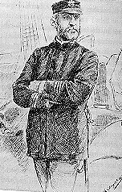 1890: UNITED STATES. Alfred T. Mahan, head of the U.S. Naval War College, publishes The Influence of Sea Power Upon History, 1600-1783, which advocates the seizure of the Caribbean Islands, Hawaii and the Philippines by the United States in order to construct military bases. Mahan also advocates the building of a canal from the Atlantic to the Pacific and the creation of a "Great White Fleet" of steam-driven, armored battleships with which to carry it all out. Mahan's book becomes the blueprint for the further expansion of the American Empire in the latter part of the nineteenth century.
1890: UNITED STATES. Alfred T. Mahan, head of the U.S. Naval War College, publishes The Influence of Sea Power Upon History, 1600-1783, which advocates the seizure of the Caribbean Islands, Hawaii and the Philippines by the United States in order to construct military bases. Mahan also advocates the building of a canal from the Atlantic to the Pacific and the creation of a "Great White Fleet" of steam-driven, armored battleships with which to carry it all out. Mahan's book becomes the blueprint for the further expansion of the American Empire in the latter part of the nineteenth century.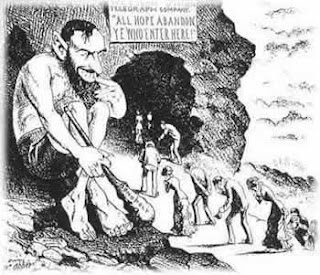 1890s-ongoing: UNITED STATES. The era of the robber barons begins in deadly earnest. The great fortunes of the Rockefellers, the Harrimans, the Mellons, the Goulds, the Carnegies and the other members of the U.S. ruling class along with the lesser fortunes of their lackeys and front men, which will soon include the Bush family and the Dulles brothers, are acquired through a mix of criminality, conspiracy, utter ruthlessness and the bribery and outright ownership of politicians of all stripes. It is all driven by an unquenchable greed for money and power and delusions of superiority.
1890s-ongoing: UNITED STATES. The era of the robber barons begins in deadly earnest. The great fortunes of the Rockefellers, the Harrimans, the Mellons, the Goulds, the Carnegies and the other members of the U.S. ruling class along with the lesser fortunes of their lackeys and front men, which will soon include the Bush family and the Dulles brothers, are acquired through a mix of criminality, conspiracy, utter ruthlessness and the bribery and outright ownership of politicians of all stripes. It is all driven by an unquenchable greed for money and power and delusions of superiority.
The few who understand the system,
will either be so interested in its profits,
or so dependent on its favors
that there will be no opposition
from that class,
while on the other hand,
the great body of people,
mentally incapable of comprehending
the tremendous advantages..
will bear its burden without complaint,
and perhaps without suspecting
that the system
is inimical to their best interests.
1891: UNITED STATES. A mob of ten thousand whites storms the Omaha, Nebraska jail and takes a black accused, Joe Coe, from his cell. He is beaten and lynched. Six thousand people reportedly visit the display of Coe's corpse and purchase pieces of the rope used to lynch him as souvenirs.
1891-present: HAITI. The U.S. invades Haiti to suppress a revolt of black workers against horrific working conditions on Navassa Island and seizes the island itself, which it still holds.
1891: CHILE. U.S. Marines invade Chile to suppress nationalists rebelling against the U.S.-supported dictatorship.
1891: CHILE. One hundred and twenty sailors from the USS Baltimore receive shore leave in Valparaiso, Chile. They become involved in bar brawls and street violence resulting in the death of two Americans, the wounding of seventeen, and the imprisonment of thirty-six. The U.S.demands a Chilean apology and reparations. The Chileans conduct an investigation which finds that drunken American sailors provoked the disturbances. In his annual message to Congress, President Benjamin Harrison threatens to seek congressional approval for a U.S. invasion of Chile.
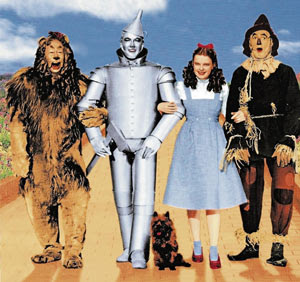 1891: UNITED STATES. L. Frank Baum, beloved author of the Wizard Of Oz, writes in the Aberdeen, Kansas Saturday Pioneer that the U.S. Army should “finish the job” of the “total annihilation” of the few remaining Indians in the U.S. By 1891, Baum's call for mass murder was almost redundant. Through ruthless genocide carried out by the United States Government, the native population of the U.S. had been reduced to 2.5% of its original numbers and 98% of Indian land had already been stolen, almost all in violation of legally binding treaties. Hundreds of native American nations with unique languages and customs had been erased from the face of the Earth.
1891: UNITED STATES. L. Frank Baum, beloved author of the Wizard Of Oz, writes in the Aberdeen, Kansas Saturday Pioneer that the U.S. Army should “finish the job” of the “total annihilation” of the few remaining Indians in the U.S. By 1891, Baum's call for mass murder was almost redundant. Through ruthless genocide carried out by the United States Government, the native population of the U.S. had been reduced to 2.5% of its original numbers and 98% of Indian land had already been stolen, almost all in violation of legally binding treaties. Hundreds of native American nations with unique languages and customs had been erased from the face of the Earth.
1892: UNITED STATES. On behalf of corporate interests, U.S. troops violently suppress a silver miners’ strike in Idaho.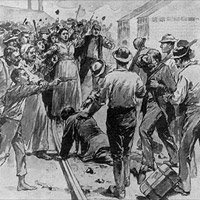 1892: UNITED STATES. A Pinkertons goon squad opens fire on striking steelworkers at the Carnegie mill in Homestead, Pennsylvania. In the ensuing battle, three Pinkertons surrender and are then beaten by a mob consisting mainly of women. Seven Pinkertons and eleven strikers and spectators are shot to death.
1892: UNITED STATES. A Pinkertons goon squad opens fire on striking steelworkers at the Carnegie mill in Homestead, Pennsylvania. In the ensuing battle, three Pinkertons surrender and are then beaten by a mob consisting mainly of women. Seven Pinkertons and eleven strikers and spectators are shot to death.
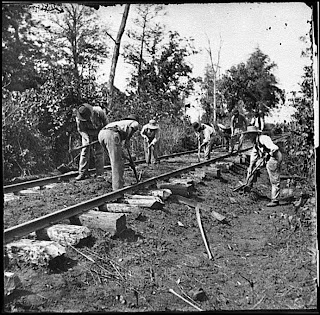 1893: UNITED STATES. Now that Thomas Durant and the boys have got their railroads built on all that stolen Indian land, it's time to get them filthy Chinks out of the U.S. White Americans help by systematically persecuting people of Chinese descent, driving them from their homes and, often, murdering them.
1893: UNITED STATES. Now that Thomas Durant and the boys have got their railroads built on all that stolen Indian land, it's time to get them filthy Chinks out of the U.S. White Americans help by systematically persecuting people of Chinese descent, driving them from their homes and, often, murdering them.
The U.S. Supreme Court once again stands in the forefront of racism and injustice, crushing whatever tattered shreds of liberty and equality actually exist in America. The Court upholds The Chinese Exclusion Act barring people of Chinese descent from the U.S. Institutionalized racism is a matter of self-preservation, says the Court, and the "natural right of the government". In the Fong Yue Ting case, the Court provides a cloak of spurious legality to the deportation of Chinese immigrants without benefit of due process.
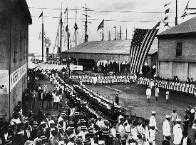 1893-present: HAWAII. A stage-managed coup of American sugar and fruit tycoons, led by Sanford Dole, overthrows the democratically-elected government of the independent nation of Hawaii with the help of troops sent ashore from the USS Boston anchored in Hololulu Harbor. U.S. Minister to Hawaii, John L. Stevens, "assists" in the establishment of a “provisional” government. U.S. Marines remain in illegal occupation. The goal of Dole and his unindicted co-conspirators is to have Hawaii annexed by the United States so that the U.S. import duty on Hawaiian sugar will be eliminated, thereby increasing the sugar barons' profits. Apparently Dole and the boys just can’t make enough money to be happy, even using whips to encourage their workers in the cane fields.
1893-present: HAWAII. A stage-managed coup of American sugar and fruit tycoons, led by Sanford Dole, overthrows the democratically-elected government of the independent nation of Hawaii with the help of troops sent ashore from the USS Boston anchored in Hololulu Harbor. U.S. Minister to Hawaii, John L. Stevens, "assists" in the establishment of a “provisional” government. U.S. Marines remain in illegal occupation. The goal of Dole and his unindicted co-conspirators is to have Hawaii annexed by the United States so that the U.S. import duty on Hawaiian sugar will be eliminated, thereby increasing the sugar barons' profits. Apparently Dole and the boys just can’t make enough money to be happy, even using whips to encourage their workers in the cane fields.
After a bit of singing and dancing, the U.S. permanently occupies Hawaii as a colony on behalf of U.S. sugar and fruit interests and as a base for the extension of American military power into the Pacific. The U.S. remains in illegal occupation of the independent nation of Hawaii until the present day.
1893-1896: UNITED STATES. Years of rampant speculation and scams in the railroad biz bring about the Crash of 1893. Railroads fail one after the other. As yet another "investment" bubble bursts, Americans rush to withdraw their savings from the banks before they collapse. Americans attempting to redeem their dollar bills for gold, as promised, find that the U.S. government doesn't have enough gold to redeem all the bills in circulation. Many stocks and bonds held by Americans become worthless. In total, more than five hundred banks and fifteen thousand other businesses fail. Commodity prices fall, driving farmers into bankruptcy. Unemployment reaches almost twenty percent. Americans lose their farms, homes and businesses in large numbers. Many abandon their homes and farms and move west.
In total, more than five hundred banks and fifteen thousand other businesses fail. Commodity prices fall, driving farmers into bankruptcy. Unemployment reaches almost twenty percent. Americans lose their farms, homes and businesses in large numbers. Many abandon their homes and farms and move west.
The Klondike gold rush helps to end the depression and, from 1896 to 1907, things are looking up and then.....the Panic of 1907.
1894: UNITED STATES. President-to-be Theodore Roosevelt gives his racism a little exercise when he opines that, “All men of sane and wholesome thought must dismiss with impatient contempt the plea that these continents should be reserved for the use of scattered savage tribes, whose life was but a few degrees less meaningless, squalid, and ferocious than that of the wild beasts with whom they held joint ownership.”
1894: HAWAII. On July 4, 1894, the date being chosen with care, fruit lord Sanford Dole announces the invention of the Republic of Hawaii, and modestly declares himself president.
1894: UNITED STATES. After Dole and the boys have overthrown the legal government of the nation of Hawaii, and after the U.S. has conducted an armed invasion and occupation of Hawaii and seized it as a colony on behalf of the Dole family and its minions, the whores and shills of the U.S. Senate venture into stratospheric levels of hypocrisy when they pass a resolution warning "foreign governments not to interfere in Hawaiian political affairs."
 1894: UNITED STATES. The World's Columbian Exposition in Chicago's Jackson Park is set on fire by strikers protesting a drastic reduction in wages by the Pullman company. The federal government intervenes and uses 14,000 federal and state troops to crush the strike. Thirty four workers are killed by troops.
1894: UNITED STATES. The World's Columbian Exposition in Chicago's Jackson Park is set on fire by strikers protesting a drastic reduction in wages by the Pullman company. The federal government intervenes and uses 14,000 federal and state troops to crush the strike. Thirty four workers are killed by troops.
1894: NICARAGUA. The U.S. invades Nicaragua at Bluefields to “protect American interests”.
1894: BRAZIL. The U.S. uses a display of naval power to intimidate Brazil. 1894: HAWAII. Hawaiians and non-Hawaiian supporters of the legitimate government of the island nation launch an uprising against the illegal dictatorship of sugar barons which had stolen their country. They are defeated by overwhelming force and the dictatorship captures Queen Lili`uokalani and holds her prisoner. The Queen is coerced into signing a document of abdication which actually had no validity since abdication is not provided for in the Hawaiian Constitution. In spite of the promises made to the Queen, five Hawaiian patriots are sentenced to death and others to long prison sentences by the kangaroo courts of the dictatorship.
1894: HAWAII. Hawaiians and non-Hawaiian supporters of the legitimate government of the island nation launch an uprising against the illegal dictatorship of sugar barons which had stolen their country. They are defeated by overwhelming force and the dictatorship captures Queen Lili`uokalani and holds her prisoner. The Queen is coerced into signing a document of abdication which actually had no validity since abdication is not provided for in the Hawaiian Constitution. In spite of the promises made to the Queen, five Hawaiian patriots are sentenced to death and others to long prison sentences by the kangaroo courts of the dictatorship.
Hypocrisy knows no limits when Queen Lili`uokalani, the legal and constitutional head of the government of Hawaii, is charged with misprision of treason and is sentenced to five years imprisonment at hard labor and a $5,000 fine for attempting to overthrow the criminals who had stolen the nation of Hawaii. Upon gaining her freedom, Lili`uokalani travels to Washington, to ask President Cleveland to reinstate democratic, constitutional government in Hawaii. He refuses.
(Ed: But not ashamed enough
to return Hawaii to the Hawaiians.)
1894-95: CHINA. U.S. troops invade China to “protect American interests” and “infiltrate” Peking.
1894-96: KOREA. U.S. troops invade Korea to “protect American interests”.
 1894: UNITED STATES. Hundreds of unemployed Americans, led by Jacob Coxey, march across the United States toward Washington to protest conditions during the worst depression to date in U.S. history following the Panic of 1893. The marchers become known as Coxey's Army. Hundreds of marchers on their way from the northwest are stopped by federal troops in Montana. More than five hundred do make it to Washington, DC but, democratic protest being strictly verboten, Coxey and the other leaders of the protest are arrested for "walking on the grass of the United States Capitol."
1894: UNITED STATES. Hundreds of unemployed Americans, led by Jacob Coxey, march across the United States toward Washington to protest conditions during the worst depression to date in U.S. history following the Panic of 1893. The marchers become known as Coxey's Army. Hundreds of marchers on their way from the northwest are stopped by federal troops in Montana. More than five hundred do make it to Washington, DC but, democratic protest being strictly verboten, Coxey and the other leaders of the protest are arrested for "walking on the grass of the United States Capitol."
The war plan is the embodiment of the blueprint for American Empire published by the head of the Naval War College, Alfred T. Mahan, in 1890.
In 1894, the U.S. begins the destabilization of Cuba, its third-largest trading partner, by imposing huge tariffs on Cuban sugar imports, all but wrecking the Cuban economy. By fabulous coincidence, this works very much to the benefit of sugar baron Sanford Dole and his gang of thugs who have just stolen Hawaii from the Hawaiians.
In 1896, the war plan is finalized by Lieutenant William W. Kimball, a naval intelligence officer at the War College. Kimball's plan includes not just attacks on Cuba and the Philippines but on the Mediterranean coast of Spain. In early 1898, the U.S. Department of the Navy begins operational preparations for attacks on Cuba and Puerto Rico. During the same period, U.S. newspapers and magazines conduct a massive propaganda campaign preparing the American public for the planned war. The script of the propaganda campaign is supposed U.S. support of Cuban rebels who are attempting to free Cuba of Spanish colonial rule. And if you believe that load of malarkey, I have a nice bridge I'd like to sell to you.
The propaganda campaign features countless largely fabricated stories of atrocities by the Spanish and, since you have to have one identifiable bad guy on whom to focus all the manufactured hate, the systematic demonization of Spanish General Valeriano Weyler, who is referred to in the "news"papers of yellow journalist and Nazi mouthpiece-to-be William Randolph Hearst as “Butcher” Weyler. Among the fabricated atrocities which Hearst, Pulitzer and other yellow media owners use to inflame the U.S. public are invented tales of Spanish attacks on hospitals, rape, poisoning of wells and, as the icing on the cake, gruesome, completely fictitious, accounts of “roasting twenty five Catholic priests alive”. The roasted priest lie sounds like a rehearsal for the "evil Iraqi soldiers throwing Kuwaiti babies out of incubators" lie which the U.S. mass media will obediently carry a hundred years later. Nice to know some things are consistent in this uncertain world. As is the case today, the press in the nineteenth century was strangely silent about real atrocities and crimes being carried out by U.S.-supported dictators such as Porfirio Diaz in Mexico whose genocides directly benefited Hearst.
And all that is needed to make the "splendid little war" happen is the nineteenth century version of a Pearl Harbor or 9-11 "event", as such things are called in the war biz. Stay tuned for the next exciting instalment of Making The World Safe For Hypocrisy and we'll see what the boys come up with.
